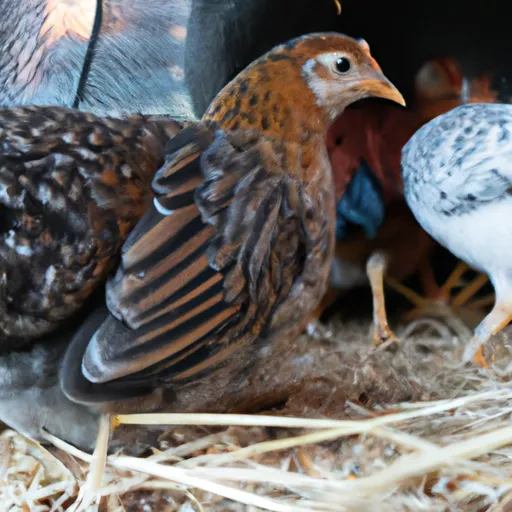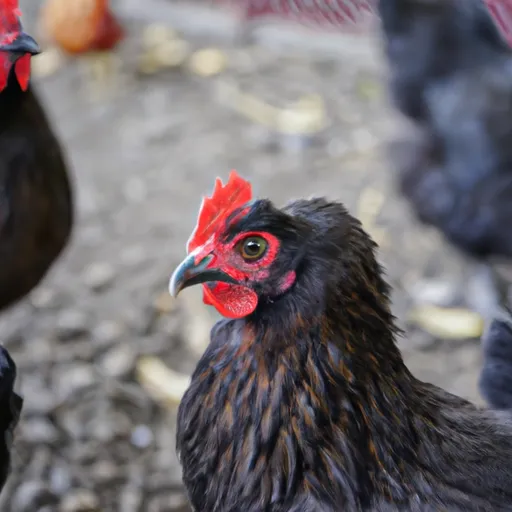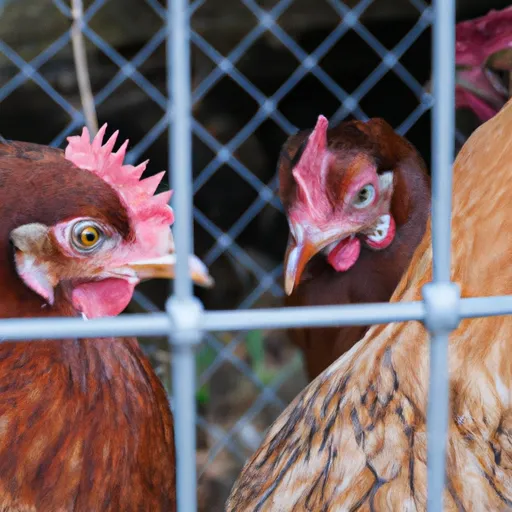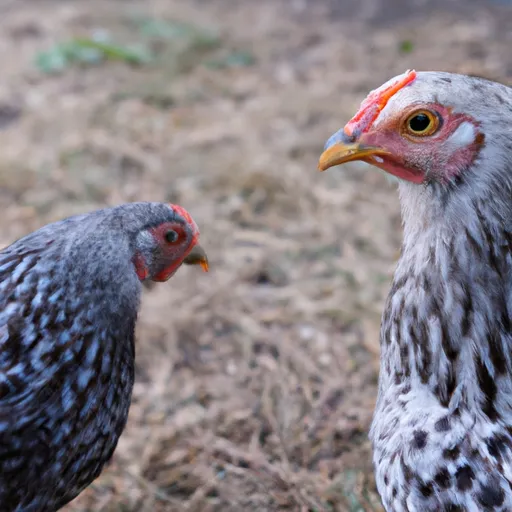What Makes Ameraucana Chickens Unique?
What Makes Ameraucana Chickens Unique?
So, you've heard about Ameraucana chickens, but do you really know what makes them unique?
Well, let me tell you.
Ameraucana chickens are best known for their strikingly beautiful blue eggs.
Yes, you heard it right, blue eggs!
These chickens are not only visually captivating but also come in a wide range of feather colors and patterns, adding a touch of vibrancy to any flock.
But their distinct features don't stop there. Ameraucanas are also well-regarded for their small pea combs and muffs, giving them an adorable fluffed appearance.
If you're a chicken enthusiast or simply curious about these unique creatures, keep reading to uncover more fascinating details about Ameraucana chickens.
Physical Characteristics
Size
Ameraucana chickens are considered a medium-sized breed, with males typically weighing between 6.5 to 7.5 pounds and females ranging from 5.5 to 6.5 pounds.
These birds have a robust build and a solid overall appearance, making them an aesthetically pleasing addition to any backyard flock.
Feathers
One of the distinguishing features of Ameraucanas is their unique feathering. They have a full plumage that gives them a fluffy and soft appearance.
Ameraucanas possess both a beard and muffs, which are clusters of feathers around their face, enhancing their charm. These adorable fluffy cheeks are often a favorite among chicken enthusiasts.
Variety of Colors
Ameraucanas come in a wide range of stunning colors. The American Poultry Association recognizes eight recognized varieties: Black, Blue, Blue Wheaten, Brown Red, Buff, Silver, White, and Wheaten.
Each color variation showcases its own beauty, delighting chicken keepers with a diverse palette to choose from. Whether you prefer a bold and striking black or a delicate and elegant silver, there is an Ameraucana color variety for every enthusiast.
Origins and History
South America
Ameraucana chickens have their roots in South America, with their ancestors originating from the Araucana chickens of Chile.

The Araucana breed was highly valued by the Mapuche people for their blue eggs, and their genetics played a significant role in shaping the Ameraucana breed we know today.
The migration of Araucanas to the United States in the early 20th century marked the beginning of the Ameraucana's journey.
Standardization of Breed
The process of standardizing the Ameraucana breed began in the 1970s, led by dedicated breeders who sought to create a true breed that retained the desirable traits of the Araucanas while addressing some of their shortcomings.
Through stringent breeding programs, these passionate individuals worked towards establishing a breed that consistently produced the signature blue eggs and maintained the unique physical characteristics.
Recognition by American Poultry Association
In 1984, the Ameraucana breed was officially recognized by the American Poultry Association (APA).
This recognition solidified the Ameraucana's status as a distinct breed, allowing for participation in poultry shows and competitions.
The APA sets the standards for Ameraucana chickens, ensuring that breeders and enthusiasts alike have a clear guideline to follow when assessing and breeding these birds.
Egg Production
Egg Color
One of the most prominent features of Ameraucana chickens is their ability to lay eggs with vibrant blue shells. This is a result of the blue eggshell gene inherited from their Araucana ancestors.
The unique blue hue of their eggs makes them highly sought after and adds a pop of color to any egg basket. The intensity of the blue can vary, with some eggs displaying a lighter shade, while others boast a deeper, more vibrant blue.
Egg Size
Ameraucana hens are known to lay medium-sized eggs. While they may not produce the largest eggs among chicken breeds, the consistent size makes them suitable for many culinary purposes.
These eggs are typically comparable to the size of a store-bought large egg, making them versatile for both cooking and baking.
Egg Yield
In terms of egg production, Ameraucanas are reliable layers, providing a steady supply of eggs throughout the year. On average, a healthy Ameraucana hen can lay around 200-250 eggs annually.
However, it's worth noting that individual hens may vary in their egg-laying tendencies. Factors such as age, health, and environmental conditions can influence the consistency of their egg yield.
Personality and Behavior
Temperament
Ameraucanas are known for their calm and friendly temperament, making them an excellent choice for families or individuals seeking a chicken breed that is easy to handle.
They are generally sociable and enjoy human interaction, making them a delight to keep as pets. Ameraucanas tend to be less flighty and skittish compared to some other chicken breeds, which can make them more approachable and less prone to stress.
Foraging Abilities
Ameraucanas have a strong foraging instinct and are highly skilled at finding their own food.
This makes them well-suited for free-range environments where they can utilize their natural instincts to hunt for insects and graze on vegetation.
Their resourcefulness and self-sufficiency can be a benefit in terms of reducing feed costs and promoting a more natural lifestyle for the chickens.
Roosting Habits
Like most chickens, Ameraucanas have a natural inclination to roost. They prefer to sleep in elevated areas, such as roosting bars or perches.
Providing adequate roosting space is important to ensure their comfort and well-being. Ameraucanas will often huddle together while roosting, exhibiting their social nature as they seek warmth and security within the flock.
Health and Care
Hardiness
Ameraucanas are generally regarded as a hardy breed, able to withstand various weather conditions.
Their fluffy feathers provide insulation, protecting them from both cold and heat.
However, proper care and attention are still necessary to maintain their well-being.
Providing a clean and predator-secure coop, regular health check-ups, and a balanced diet will contribute to the overall health and longevity of Ameraucana chickens.
https://thebackyardchickens.com/chicken-diet-101-what-not-to-include-in-their-meal-plan/
Diet
Ameraucanas require a nutritionally balanced diet to thrive. A high-quality layer feed, supplemented with fresh fruits, vegetables, and occasional treats, will provide the necessary nutrients for optimal health and egg production.
It is important to ensure that they have access to clean water at all times. Additionally, providing opportunities for them to forage and scratch for insects and plants will promote natural behaviors and overall well-being.
Predator Protection
Just like any other chicken breed, Ameraucanas are vulnerable to predators.
Secure fencing, sturdy coops, and proper locking mechanisms are essential to protect them from predators such as raccoons, foxes, and even neighborhood dogs.
Regular inspections of the coop and surrounding area will help identify and address any potential weak points that could compromise their safety.

Exhibition Qualities
Show Standards
The American Poultry Association has established stringent show standards for Ameraucana chickens. These standards outline the ideal physical characteristics that judges consider when evaluating birds in poultry shows.
These standards encompass various aspects, including body shape, feather pattern, color, and overall attractiveness.
Breeding programs often strive to produce Ameraucanas that meet and excel at these show standards, contributing to the breed's preservation and improvement.
Judging Criteria
When judging Ameraucana chickens, judges assess various factors to determine the quality and conformity of the bird.
They look for traits such as the correct size, well-defined feather patterns, appropriate coloring, and adherence to the breed's physical characteristics.
Judges also consider the condition and health of the bird, including its posture, feather condition, and overall vitality. Additionally, judges evaluate the bird's temperament and behavior to ensure it meets breed-specific requirements.
Recognized Varieties
The Ameraucana breed encompasses various recognized color varieties.
The American Poultry Association acknowledges eight recognized Ameraucana varieties: Black, Blue, Blue Wheaten, Brown Red, Buff, Silver, White, and Wheaten.
Each variety possesses its own unique and eye-catching characteristics, allowing breeders to focus on specific colors or patterns based on their preferences and goals.
Parent Breeds
Araucana
The Araucana breed, native to South America, played a significant role in the development of the Ameraucana breed.
Known for their unique blue eggs, muffs, and tufted appearance,
Araucanas brought these distinctive traits to the Ameraucana breed. The combination of traits from the Araucana and other parent breeds ultimately resulted in the Ameraucana's captivating and sought-after features.
Leghorn
Leghorns, a breed known for their prolific egg-laying capabilities, also influenced the development of Ameraucanas.
Breeders incorporated Leghorn genetics to improve the Ameraucana's egg production without compromising their distinctive blue eggshell color.
Through careful breeding and selection, Ameraucanas now possess a good balance of the desirable traits inherited from both the Araucana and Leghorn breeds.
Ameraucana Cross Breeds
Through selective breeding, other chicken breeds have been crossed with Ameraucanas to create unique hybrid chickens.
These Ameraucana cross breeds often retain some of the signature physical traits of the Ameraucana while introducing additional characteristics from the other parent breeds.
These crosses can result in a wide array of beautiful chickens, each with their own distinctive appearance and qualities.
Brooding and Hatching
Broody Tendencies
Ameraucanas, as a breed, do not have strong inherent broody tendencies. They are generally not as likely to go broody compared to some other breeds that are known for their nurturing instincts.
This can be advantageous for those who are primarily focused on egg production but may require alternative methods for hatching eggs if desired.
Incubation Period
When Ameraucana eggs are successfully fertilized, they typically require an incubation period of approximately 21 days.
During this time, it is crucial to maintain proper temperature and humidity levels inside the incubator to ensure steady embryo development.
Regular monitoring and adjustments are necessary to provide the ideal conditions for a successful hatching experience.
Chick Rearing
Once the Ameraucana chicks hatch, they will require a suitable brooder setup for their initial weeks of life. The brooder should provide sufficient warmth, ventilation, and protection from potential hazards.
A balanced chick starter feed and access to clean water are essential for their growth and development. Establishing a routine for regular feeding, cleaning, and gentle handling will contribute to raising healthy and well-adjusted Ameraucana chicks.
Avian Genetics
Blue Eggshell Gene
The unique blue eggshell color of Ameraucanas is a result of a specific gene known as the "blue eggshell gene."
This gene is inherited from their Araucana ancestors and gives Ameraucana eggs their distinct appearance. It is considered a dominant gene, meaning that if an Ameraucana carries a blue eggshell gene, it will pass on that trait to its offspring.
Other Unique Genes
In addition to the blue eggshell gene, Ameraucanas possess other distinctive genes that contribute to their appearance.
The beard and muffs, for example, are caused by a specific gene that creates these clusters of feathers around their face.
These genetic variations make Ameraucanas captivating in both appearance and genetic composition.
Breeding Challenges
Breeding Ameraucanas requires careful attention to genetic traits and selection.
Breeders must properly manage and evaluate the presence of specific genes to ensure desired traits are passed on and maintained in the breed.
Challenges can arise when attempting to achieve the perfect balance of physical characteristics, egg production, and overall health.
Diligent breeding programs and a thorough understanding of avian genetics are crucial in maintaining the integrity and excellence of the Ameraucana breed.
Ameraucanas as Pets
Family-friendly
Ameraucanas are often touted as family-friendly chickens due to their gentle nature and easy-going temperament.

They can be a wonderful addition to households with children, as they generally tolerate human interaction well. Children can learn valuable lessons in responsibility and compassion by caring for these intelligent and endearing pets.
Trainability
Ameraucanas, like many chicken breeds, can be trained to a certain extent.
By introducing positive reinforcement techniques, such as clicker training or offering treats, it is possible to teach Ameraucanas basic commands or encourage certain behaviors.
They can learn to recognize their names, come when called, or even perform simple tricks.
The trainability of individual chickens can vary, but with patience and consistency, Ameraucanas can be responsive and cooperative learners.
Noise Level
In terms of noise, Ameraucanas are generally considered relatively quiet compared to some other chicken breeds.

While they may occasionally announce the arrival of an egg or vocalize during times of excitement or distress, their overall noise level is typically manageable and unlikely to disturb neighbors or cause excessive noise-related issues.
However, it's important to note that individual chickens may exhibit variations in their vocalization tendencies, and factors such as breeding, environment, and flock dynamics can influence noise levels.
Ameraucana chickens possess a unique combination of physical characteristics, genetic traits, and temperamental qualities that make them a sought-after breed among chicken enthusiasts.
From their fluffy plumage and variety of vibrant colors to their ability to produce blue eggs, Ameraucanas truly stand out in a flock. Their South American origins, standardization of the breed, and recognition by organizations like the American Poultry Association attest to their historical and contemporary significance.
Whether you are looking for a reliable egg layer, an exhibition-quality bird, or a family-friendly pet, Ameraucanas offer an exceptional choice that combines beauty, utility, and friendliness.
